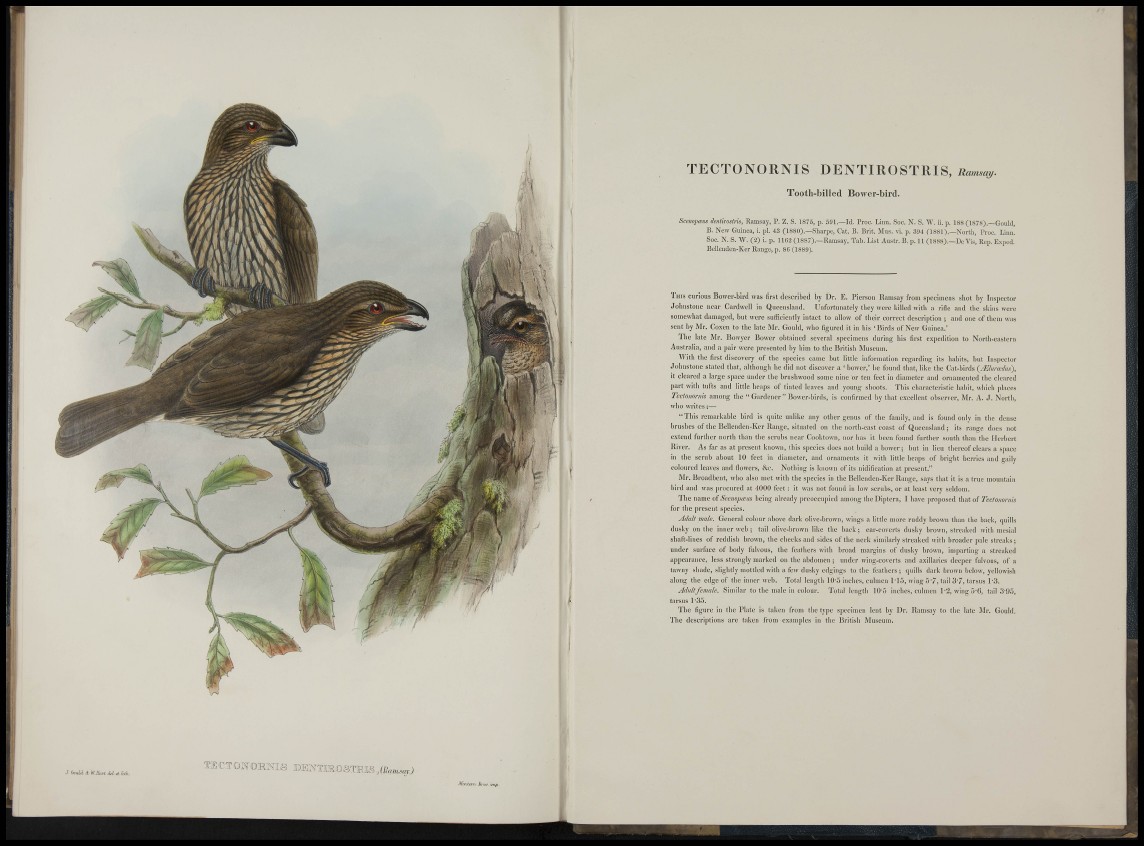
T E C T O N O R N I S DENTIROSTRIS, iiamsaj,.
Tooth-billed Bower-bird.
Scenojusus ientirostris, Ramsay, P. Z. S. 1875, p. 591.—Id. Proc. Linn. Soc. N. S. W. ii. p. 188 (1878).—Gould,
B. New Guinea, i. pi. 43 (1880).—Sliarpe, Cat. B. Brit. Mus. vi. p. 394 (1881).—Nortli, Proc. Linn.
Soc. N. S. W. (2) i. p. 1162 (1887).—Ramsay, Tab. List Austr. B. p. 11 (1888).—De Vis, Rep. E.-cped.
Bellenden-Ker Range, p. 86 (1889).
THIS curious Bower-bird was first described by Dr. E. Piersoii Rauisay from specimens sliot by Ins|)cctor
Jolinstoiie near Cardwcll in Queeiislaiul. Uufortunately tliey were killed with a rille and tlie skins were
somewhat damaged, but were sufficiently intact to allow of their correct description ; aiul one of tbcni was
sent by Mr. Coxeu to the late Mr. Gould, who figured it in his 'Birds of New Guinea.'
The late Mr. Bowyer Bower obtained several s|)ecimcns during bis first e.\')iedition to North-eastern
Australia, aiul a pair were presented by liim to the British Museum.
With the first discovery of the species came but little information regarding its habits, but Inspector
Johnstone stated that, although he did not discover a ' bower,' he found that, like the Cat-birds {/Eluradui),
it cleared a large space under the brushwood some nine or ten feet iu diameter and ornamented the cleared
part with tufts and little heaps of tinted leaves and young shoots. This cluu-acteristie habit, which places
Tcctonornis among the "Gardener " Bower-hirds, is eoufirined by that excellent observer, Mr. A. J. North,
who writes;—
"This remarlaible bird is quite unlike any other genus of the family, and is found only in the dense
brushes of the Bellenden-Ker Range, situated on the iiortli-east coast of Queensland; its range does not
extend further north than tlie scrubs near Cooktown, nor lias it been found further south than the Herbert
River. As far as at jiresent known, ibis species does not build a bower; but in lieu thereof clears a space
in the scrub about 10 feet in diameter, and ornaments it with little heaps of bright berries and gaily
coloured leaves and (lowers, &c. Nothing is known of its nidification at present."
Mr. Broadbent, who also met with the species in the Bellenden-Ker Range, says that it is a true mountain
bird and was ])rocured at 4000 feet: it was not found in low scrubs, or at least very seldom.
The name oiScenopieus beinjf already ])reoccupied among theDiptera, I have projiosed that of Tectonorms
for the present species.
Adult male. General colour above dark olive-brown, wings a little more ruddy brown than tlie hack, quills
dusky on the inner web ; tail olive-brown like the hack ; ear-coverts dusky brown, streaked with mesial
shaft-lines of reddish brown, the clieeks and sides of the neck simiUirly streaked with broader pale streaks;
uniler surface of body fulvous, the feathers with broad margins of dusky brown, inq)arting a streaked
appearance, less strongly marked on the abdomen ; under wing-coverts and axillarics dee])er fulvous, of a
tawny shade, slightly mottled with a few dusky edgings to the feathers ; quills dark brown below, yellowish
along the edge of the inner web. Total lengtli 10-5 inches, euhnen Mo , wing 5 7 , tail 3'7, tarsus 1-3.
Adult female. Similar to the male in colour. Total length 10'5 inches, culmen 1-2, wiug o'G, tail 3-05,
tarsus 1*35.
The figure in the Plate is taken from the type speciiuen lent by Dr. Ramsay to the late Mr. Gould.
The deserljitions are taken from exanqiles in the British Museum.
<xaLi <f W.liirl ii.rf Jft . TECTOI^-Oasns
Mifit&'n ¡¡TO-' f.